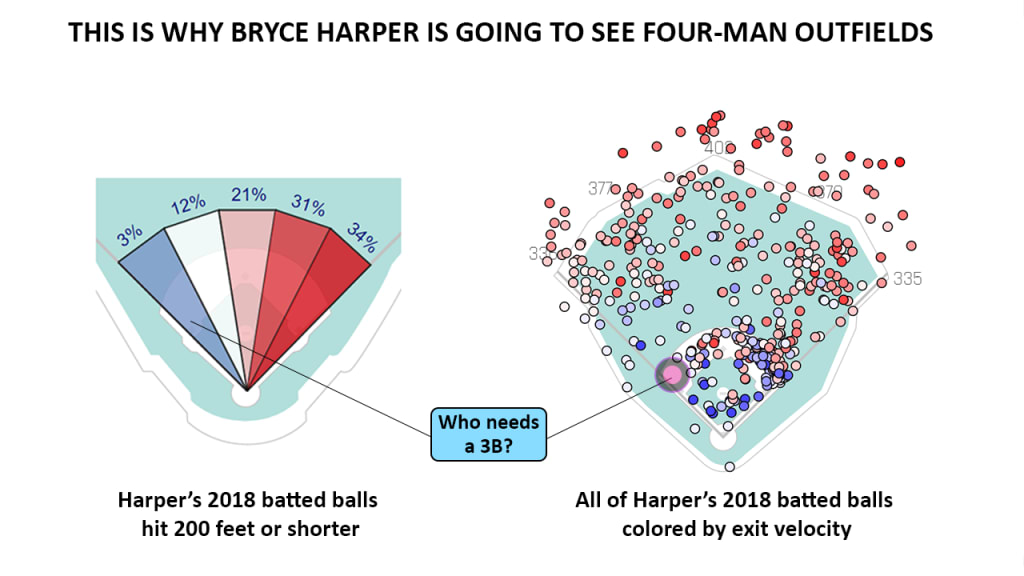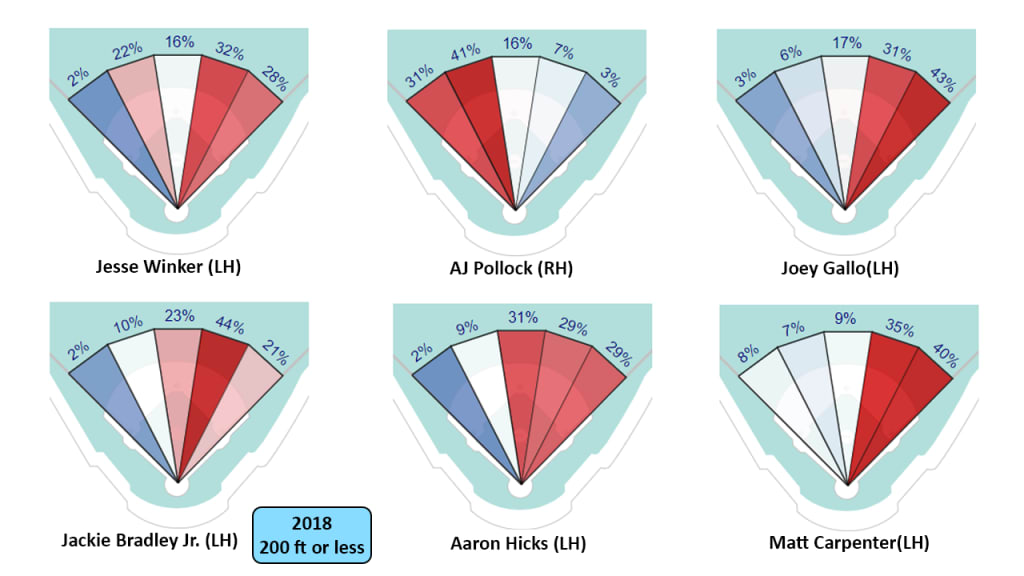In the very first plate appearance of his very first Spring Training game with the Phillies, Bryce Harper watched the Blue Jays set up with four men in the outfield. Two days later, the Rays did it to Harper, too.
"First time I've ever seen that," Harper said after the Toronto game. "It's intense."
It's not particularly difficult to see why the Jays did it. Just look at what happened last year when Harper put the ball in play. On the left, you'll see that only three percent of his batted balls projected to go 200 feet or shorter -- that is, balls likely to be collected by an infielder -- went to the third-base slice of the infield. On the right, you'll see a spray chart of all of his batted balls, showing a big gap at third base of either no batted balls or weakly hit ones.

Why waste a fielder, the thinking goes, for a spot where the ball never lands? Last year, Harper hit 193 batted balls against non-shifted infields. Just seven went to the third baseman -- and three of those were popups.
If there's something that's surprising here, it's not that Harper is seeing it in 2019. It's that he'd never seen it before. It seems that's about to change. It seems like it's not going to just be limited to Harper. Welcome to the age of the four-man outfield, 2019's positioning strategy of choice -- or at least, it looks that way based on what we've seen this spring.
On March 12, the Reds did it to Kris Bryant, the Astros did it to Matt Adams, and the Rays did it to Billy McKinney. On March 15, the Reds did it to Cody Asche. On March 16, the Blue Jays did it to Aaron Judge. On March 17, the Reds did it to Jose Ramirez. On March 19, the Rays used four outfielders against Greg Bird. On Thursday, the Rays did it to Blake Swihart. This is all new. Only Ramirez had seen this configuration before, and even that was just once, near the end of last season.
We don't have reliable Statcast tracking data at all spring sites, so we're going on word-of-mouth here. We've almost certainly missed a few instances. But it's starting to feel pretty quickly like the four-man outfield isn't a Spring Training gimmick, especially when it's happening to less-than-highly-regarded hitters like McKinney and Asche. It's something you might see a lot in 2019. You might see it more than ever.
The infield shift, in other words, is last year's news. It's been around for years, and even if it feels like we've reached "peak shift," it's still only in use about 17 percent of the time. It's not even clear if, or how much, the shift really affects offense. You've seen it. You'll continue to see it. This is the next thing. Let's explain what it is, and why.
Now that we have Statcast data, we can quantify the trend, such as it is. (For our purposes, we define an outfielder as being 220 feet away from home plate. Ever so often, a deeply shifted infielder will step over that imaginary line and count in data as a fourth outfielder, though we'll attempt to remove them here, and go with four "true" straight-up outfielders.)
In 2016, it didn't happen at all, though the Orioles came close against Victor Martinez.
In 2017, it happened just once, when the Cubs did it to Joey Votto. (He doubled anyway.)
In 2018, it happened to 15 different hitters, most of them the type of fly-ball hitting lefty power mashers you'd expect. Lucas Duda, Matt Olson, Joey Gallo, and Justin Smoak each saw at least 39 pitches with the four-man outfield on. Eight different teams used it at least once, led by the Twins, who were responsible by themselves for 68 percent of its usage. (Plus, there was at least one noted instance in the Minors, when the Durham Bulls did it to top White Sox prospect Eloy Jimenez.)
And it worked, for the most part. Last year, hitters facing the four-man outfield hit .186 with a .339 slugging percentage against it. There were 17 strikeouts in 65 plate appearances, and three homers. This isn't declarative, because we could have cherry-picked a few dozen plate appearances from these guys and also found a group with poor production. But you see the point here, which is that if you have a hitter who is likely to hit fly balls to the outfield, and very unlikely to put a grounder to one spot in the infield, why put a man in that infield spot?
Of the 11 hits against it, two were bunts to the open infield, and one was a Gallo single, though on a pitch that was well outside. That's always an option, though of course in some sense, getting a power hitter to abandon hopes of an extra-base hit for the non-guaranteed chance of a single is sort of the point.
"You see it, 'Oh, OK,'" Phillies first baseman Rhys Hoskins said after seeing it used on Harper. "It doesn’t make you do anything different, because as soon as you try to do something different, they win. If I’m trying to hit a ground ball to the right side, then they’ve done their job and I’m not doing mine. You don’t want me to bunt, I promise you."
But for all of the shiny newness of this, the four-man outfield isn't new, not exactly. Last year, the Ringer did a deep dive into the history of the tactic, and found evidence that the Reds had tried it as early as 1954 against Stan Musial, as well as that various sluggers of the 1960s and 1970s like Willie McCovey, Frank Robinson, Harmon Killebrew, and Jim Rice had seen it. We know that Mark McGwire faced it in 1999, and that Joe Maddon broke it out nearly 15 years ago against lefty sluggers like David Ortiz and Travis Hafner. Everything old is new again.
It didn't seem to bother McGwire, for what it's worth. "Why would I look out?" he told the Chicago Tribune 20 years ago. "I'm concentrating on the pitcher."
That somewhat echoes how today's hitters have been approaching it, which is to say, with a mixture of disregard and bewilderment.
"I was just confused," Judge said to MLB.com. "I didn’t even know what was going on until after. Looking at the pitcher, I could just see two guys in my peripheral, standing in the gaps. I was like, I guess center field must be in the middle and those guys must be playing the gaps pretty tight. It was a little different to see."
It didn't stop him from hitting a home run over it anyway.
"I was just like, 'Well, that's weird,'" Bryant said. "I mean, it's smart. You can kind of look at spray charts and stuff. I think we did it to [someone] last year. I don't know. It's kind of a compliment. I take it as a compliment, because it's like, 'This guy hits a lot of balls in the gaps and in the air.' That's kind of how I look at it."
That's more or less correct. What is defense, really, other than trying to put a fielder in a position where he's more likely than not to catch a batted ball? That's exactly how Rays center fielder Kevin Kiermaier described it when asked about Tampa Bay's usage of it.
“Everything we do out there is all for a purpose," said Kiermaier, "and you hope that those guys that we do play the four-man outfield against, they hit it where we think it’s going to go more times than not.”
Exactly. So: Who is a good candidate to see more of this kind of defense? This obviously gets a little complicated, because you have to factor in the tendencies of the pitcher, as well as the dimensions of the ballpark. Nothing is ever one-size-fits-all. But primarily, this is going to come down to what the hitter usually does. You're not going to do this against a heavy ground-ball hitter like Eric Hosmer, or someone who sprays his grounders to all fields, like Corey Dickerson.
Instead, what we'll do is to look at those infield spray charts, like the one shown for Harper above. We'll look for hitters who had at least 100 batted balls of 200 feet or less last year, and we'll limit it only to those who had a ground-ball rate lower than 45 percent. Here are a few good examples.

(Pollock stands out for being a righty, of course, and you can't totally abandon first base. But it's clear this won't be a lefty-only scenario.)
There's plenty others, certainly. Kyle Seager is an obvious candidate. So is Freddie Freeman. If we combine the third base and shortstop slices together, then Curtis Granderson went there only seven percent of the time, the lowest of anyone. If you never expect a ball to go to a spot, why waste a fielder there?
It's not going to always work, but then again nothing is going to always work. It's simply about putting a fielder where you think the ball might go. It's simultaneously revolutionary and merely a modern update of something the Reds tried on Musial nearly 70 years ago.
“I understand where they’re coming from,” Kiermaier added. “It’s one of those things where we know we’re taking a risk. If we make a play that we wouldn’t have with three outfielders, we’re going to look like geniuses. And other times where guys hit ground balls to a certain spot if we had the regular alignment it’s not gonna look so great."
But remember, it's not just about the outcomes. It's also about trying to trying to get the hitter to change who he is.
“Hit a lot of homers, drive the ball like you’re capable of, do exactly what you always do, be Bryce Harper,” Philadelphia manager Gabe Kapler said. "The opposition is doing their job if they change his swing," said Larry Bowa, an advisor to Philadelphia's front office, and a veteran of more than five decades in the game.
We'll see. The four-man outfield is coming to a park near you. Perhaps lots of them.
